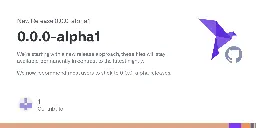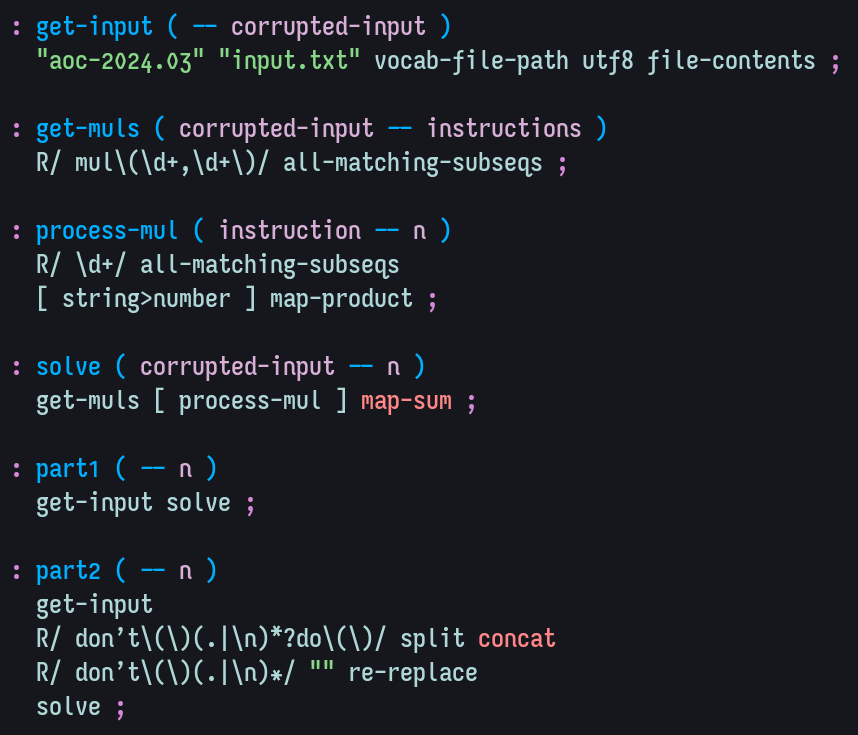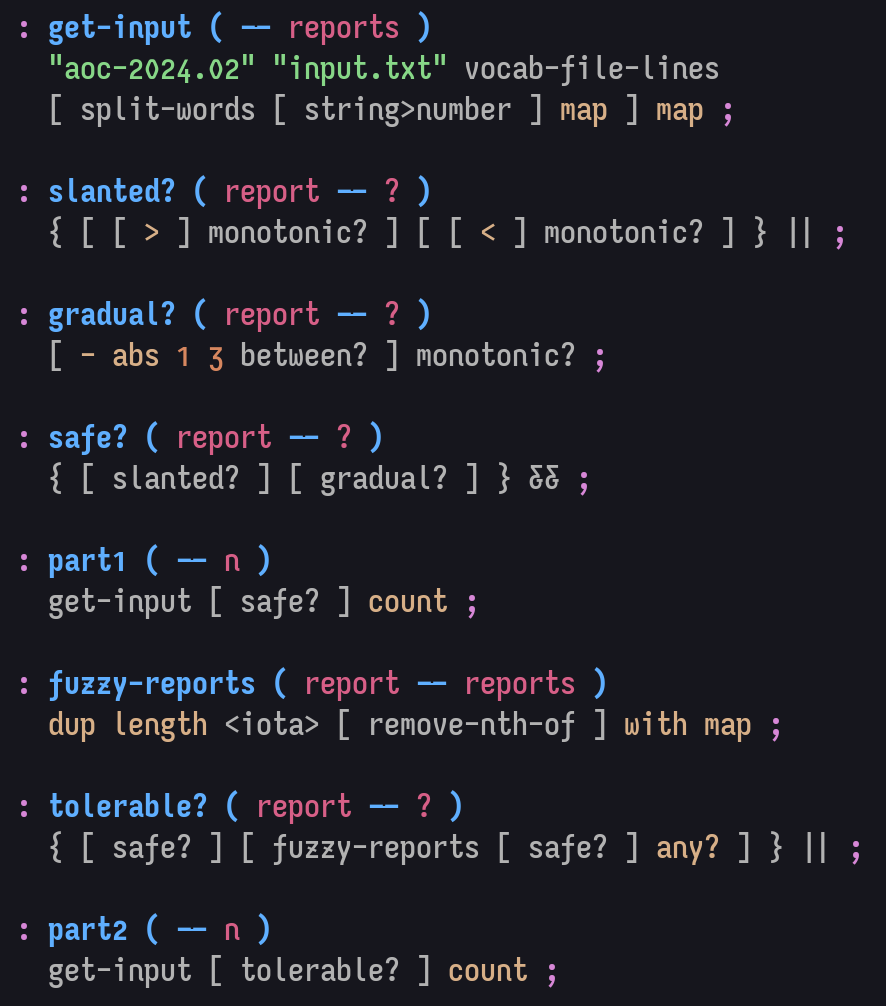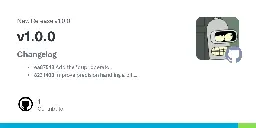zeroflag/equinox: Forth Programming Language on Lua
Forth Programming Language on Lua. Contribute to zeroflag/equinox development by creating an account on GitHub.

Discussion on lobsters:
https://lobste.rs/s/2rkupg/intensional_joy_concatenative_account
hex programming language
A tiny, minimalist, concatenative, slightly-esoteric programming language
BUND: concatenative language interpreter and shell
Contribute to vulogov/Bund development by creating an account on GitHub.

BlagojeBlagojevic/blang: Fort like lang
Fort like lang. Contribute to BlagojeBlagojevic/blang development by creating an account on GitHub.

We're starting with a new release approach, these files will stay available permanently in contrast to the latest nightly. We now recommend most users to stick to 0.0.0-alpha releases instead of ni...

Copied from the release notes:
> We're starting with a new release approach, these files will stay available permanently in contrast to the latest nightly.
> We now recommend most users to stick to 0.0.0-alpha releases instead of nightly-latest.
> This current release is based on commit a089cf2 from the 6th of January 2025. These files are identical to nightly-latest published on the 7th of January 2025.
---
EDIT: A whole lot more detail in the new 0.0.0-alpha2-rolling release
It's been a while, but my clumsy adding of a comment to the buffer is unnecessary, given zle -M, which will display a message outside of the buffer. So here's an updated version:
# -- Run input if single line, otherwise insert newline --
# Key: enter
# Credit: https://programming.dev/comment/2479198
.zle_accept-except-multiline () {
if [[ $BUFFER != *$'\n'* ]] {
zle .accept-line
return
} else {
zle .self-insert-unmeta
zle -M 'Use alt+enter to submit this multiline input'
}
}
zle -N .zle_accept-except-multiline
bindkey '^M' .zle_accept-except-multiline # Enter
# -- Run input if multiline, otherwise insert newline --
# Key: alt+enter
# Credit: https://programming.dev/comment/2479198
.zle_accept-only-multiline () {
if [[ $BUFFER == *$'\n'* ]] {
zle .accept-line
} else {
zle .self-insert-unmeta
}
}
zle -N .zle_accept-only-multiline
bindkey '^[^M' .zle_accept-only-multiline # Enter
The given Uiua example (mercifully given using words rather than the symbols):
[3 4 5 10 23]
divide length on /+
For all the talk about "forward" it's uncomfortable to me how the Uiua evaluation within a line happens backward.
An equivalent in Factor, where keep is close to on:
{ 3 4 5 10 23 }
[ sum ] keep length /
But this pattern of doing two things in sequence to the same item is common enough that bi is handy:
{ 3 4 5 10 23 }
[ sum ] [ length ] bi /
Discussion om lobsters: https://lobste.rs/s/ayiyce/spreadsheets_1_3_rye_language
Day 6
spoiler
: get-input ( -- rows )
"vocab:aoc-2024/06/input.txt" utf8 file-lines ;
: all-locations ( rows -- pairs )
dimension <coordinate-matrix> concat ;
: guard-location ( rows -- pair )
[ all-locations ] keep
'[ _ matrix-nth "<>^v" in? ] find nip ;
TUPLE: state location char ;
C: <state> state
: guard-state ( rows -- state )
[ guard-location ]
[ dupd matrix-nth ] bi <state> ;
: faced-location ( state -- pair )
[ char>> H{
{ CHAR: > { 0 1 } }
{ CHAR: v { 1 0 } }
{ CHAR: < { 0 -1 } }
{ CHAR: ^ { -1 0 } }
} at ] [ location>> ] bi v+ ;
: off-grid? ( rows location -- ? )
[ dimension ] dip
[ v<= vany? ] keep
{ 0 0 } v< vany? or ;
: turn ( state -- state' )
[ location>> ] [ char>> ] bi
H{
{ CHAR: > CHAR: v }
{ CHAR: v CHAR: < }
{ CHAR: < CHAR: ^ }
{ CHAR: ^ CHAR: > }
} at <state> ;
: obstacle? ( rows location -- ? )
swap matrix-nth CHAR: # = ;
: guard-step ( rows state -- state' )
swap over faced-location
{
{ [ 2dup off-grid? ] [ 2nip f <state> ] }
{ [ [ obstacle? ] keep-under ] [ drop turn ] }
[ swap char>> <state> ]
} cond ;
: walk-out ( rows state -- trail )
[
[ 2dup location>> off-grid? ] [
dup location>> ,
dupd guard-step
] until
] { } make 2nip ;
: part1 ( -- n )
get-input dup guard-state walk-out cardinality ;
: (walk-loops?) ( visited rows state -- looped? )
dupd guard-step
2dup location>> off-grid? [ 3drop f ] [
pick dupd in? [ 3drop t ] [
pick dupd adjoin (walk-loops?)
] if
] if ;
: walk-loops? ( rows -- looped? )
dup guard-state
[ HS{ } clone ] 2dip
pick dupd adjoin (walk-loops?) ;
: obstacle-candidates ( rows -- pairs )
[ guard-location ]
[ dup guard-state walk-out members ] bi remove ;
: part2 ( -- n )
get-input dup obstacle-candidates
[ CHAR: # spin deep-clone [ matrix-set-nth ] keep walk-loops? ] with count ;
Slow and dumb gets it done! I may revisit this when I give up on future days.
Factor
spoiler
TUPLE: equation value numbers ;
C: <equation> equation
: get-input ( -- equations )
"vocab:aoc-2024/07/input.txt" utf8 file-lines [
split-words unclip but-last string>number
swap [ string>number ] map <equation>
] map ;
: possible-quotations ( funcs numbers -- quots )
dup length 1 -
swapd all-selections
[ unclip swap ] dip
[ zip concat ] with map
swap '[ _ prefix >quotation ] map ;
: possibly-true? ( funcs equation -- ? )
[ numbers>> possible-quotations ] [ value>> ] bi
'[ call( -- n ) _ = ] any? ;
: solve ( funcs -- n )
get-input
[ possibly-true? ] with filter
[ value>> ] map-sum ;
: part1 ( -- n )
{ + * } solve ;
: _|| ( m n -- mn )
[ number>string ] bi@ append string>number ;
: part2 ( -- n )
{ + * _|| } solve ;
Nothing smart to see here. I may revisit this when I give up on future days.
Factor
spoiler
: get-input ( -- rows )
"vocab:aoc-2024/06/input.txt" utf8 file-lines ;
: all-locations ( rows -- pairs )
dimension <coordinate-matrix> concat ;
: guard-location ( rows -- pair )
[ all-locations ] keep
'[ _ matrix-nth "<>^v" in? ] find nip ;
TUPLE: state location char ;
C: <state> state
: guard-state ( rows -- state )
[ guard-location ]
[ dupd matrix-nth ] bi <state> ;
: faced-location ( state -- pair )
[ char>> H{
{ CHAR: > { 0 1 } }
{ CHAR: v { 1 0 } }
{ CHAR: < { 0 -1 } }
{ CHAR: ^ { -1 0 } }
} at ] [ location>> ] bi v+ ;
: off-grid? ( rows location -- ? )
[ dimension ] dip
[ v<= vany? ] keep
{ 0 0 } v< vany? or ;
: turn ( state -- state' )
[ location>> ] [ char>> ] bi
H{
{ CHAR: > CHAR: v }
{ CHAR: v CHAR: < }
{ CHAR: < CHAR: ^ }
{ CHAR: ^ CHAR: > }
} at <state> ;
: obstacle? ( rows location -- ? )
swap matrix-nth CHAR: # = ;
: guard-step ( rows state -- state' )
swap over faced-location
{
{ [ 2dup off-grid? ] [ 2nip f <state> ] }
{ [ [ obstacle? ] keep-under ] [ drop turn ] }
[ swap char>> <state> ]
} cond ;
: walk-out ( rows state -- trail )
[
[ 2dup location>> off-grid? ] [
dup location>> ,
dupd guard-step
] until
] { } make 2nip ;
: part1 ( -- n )
get-input dup guard-state walk-out cardinality ;
: (walk-loops?) ( visited rows state -- looped? )
dupd guard-step
2dup location>> off-grid? [ 3drop f ] [
pick dupd in? [ 3drop t ] [
pick dupd adjoin (walk-loops?)
] if
] if ;
: walk-loops? ( rows -- looped? )
dup guard-state
[ HS{ } clone ] 2dip
pick dupd adjoin (walk-loops?) ;
: obstacle-candidates ( rows -- pairs )
[ guard-location ]
[ dup guard-state walk-out members ] bi remove ;
: part2 ( -- n )
get-input dup obstacle-candidates
[ CHAR: # spin deep-clone [ matrix-set-nth ] keep walk-loops? ] with count ;
Day 5
spoiler
: get-input ( -- rules updates )
"vocab:aoc-2024/05/input.txt" utf8 file-lines
{ "" } split1
"|" "," [ '[ [ _ split ] map ] ] bi@ bi* ;
: relevant-rules ( rules update -- rules' )
'[ [ _ in? ] all? ] filter ;
: compliant? ( rules update -- ? )
[ relevant-rules ] keep-under
[ [ index* ] with map first2 < ] with all? ;
: middle-number ( update -- n )
dup length 2 /i nth-of string>number ;
: part1 ( -- n )
get-input
[ compliant? ] with
[ middle-number ] filter-map sum ;
: compare-pages ( rules page1 page2 -- <=> )
[ 2array relevant-rules ] keep-under
[ drop +eq+ ] [ first index zero? +gt+ +lt+ ? ] if-empty ;
: correct-update ( rules update -- update' )
[ swapd compare-pages ] with sort-with ;
: part2 ( -- n )
get-input dupd
[ compliant? ] with reject
[ correct-update middle-number ] with map-sum ;
Factor
: get-input ( -- rules updates )
"vocab:aoc-2024/05/input.txt" utf8 file-lines
{ "" } split1
"|" "," [ '[ [ _ split ] map ] ] bi@ bi* ;
: relevant-rules ( rules update -- rules' )
'[ [ _ in? ] all? ] filter ;
: compliant? ( rules update -- ? )
[ relevant-rules ] keep-under
[ [ index* ] with map first2 < ] with all? ;
: middle-number ( update -- n )
dup length 2 /i nth-of string>number ;
: part1 ( -- n )
get-input
[ compliant? ] with
[ middle-number ] filter-map sum ;
: compare-pages ( rules page1 page2 -- <=> )
[ 2array relevant-rules ] keep-under
[ drop +eq+ ] [ first index zero? +gt+ +lt+ ? ] if-empty ;
: correct-update ( rules update -- update' )
[ swapd compare-pages ] with sort-with ;
: part2 ( -- n )
get-input dupd
[ compliant? ] with reject
[ correct-update middle-number ] with map-sum ;
Factor
spoiler
: get-input ( -- rows )
"vocab:aoc-2024/04/input.txt" utf8 file-lines ;
: verticals ( rows -- lines )
[ dimension last [0..b) ] keep cols ;
: slash-origins ( rows -- coords )
dimension
[ first [0..b) [ 0 2array ] map ] [
first2 [ 1 - ] [ 1 (a..b] ] bi*
[ 2array ] with map
] bi append ;
: backslash-origins ( rows -- coords )
dimension first2
[ [0..b) [ 0 2array ] map ]
[ 1 (a..b] [ 0 swap 2array ] map ] bi* append ;
: slash ( rows origin -- line )
first2
[ 0 [a..b] ]
[ pick dimension last [a..b) ] bi* zip
swap matrix-nths ;
: backslash ( rows origin -- line )
[ dup dimension ] dip first2
[ over first [a..b) ]
[ pick last [a..b) ] bi* zip nip
swap matrix-nths ;
: slashes ( rows -- lines )
dup slash-origins
[ slash ] with map ;
: backslashes ( rows -- lines )
dup backslash-origins
[ backslash ] with map ;
: word-count ( line word -- n )
dupd [ reverse ] dip
'[ _ subseq-indices length ] bi@ + ;
: part1 ( -- n )
get-input
{ [ ] [ verticals ] [ slashes ] [ backslashes ] } cleave-array concat
[ "XMAS" word-count ] map-sum ;
: origin-adistances ( rows origins line-quot: ( rows origin -- line ) -- origin-adistances-assoc )
with zip-with
"MAS" "SAM" [ '[ [ _ subseq-indices ] map-values ] ] bi@ bi append
harvest-values
[ [ 1 + ] map ] map-values ; inline
: a-coords ( origin-adistances coord-quot: ( adistance -- row-delta col-delta ) -- coords )
'[ first2 [ @ 2array v+ ] with map ] map-concat ; inline
: slash-a-coords ( rows -- coords )
dup slash-origins [ slash ] origin-adistances
[ [ 0 swap - ] keep ] a-coords ;
: backslash-a-coords ( rows -- coords )
dup backslash-origins [ backslash ] origin-adistances
[ dup ] a-coords ;
: part2 ( -- n )
get-input [ slash-a-coords ] [ backslash-a-coords ] bi
intersect length ;
Better viewed on GitHub.
Day 4
spoiler
: get-input ( -- rows )
"vocab:aoc-2024/04/input.txt" utf8 file-lines ;
: verticals ( rows -- lines )
[ dimension last [0..b) ] keep cols ;
: slash-origins ( rows -- coords )
dimension
[ first [0..b) [ 0 2array ] map ] [
first2 [ 1 - ] [ 1 (a..b] ] bi*
[ 2array ] with map
] bi append ;
: backslash-origins ( rows -- coords )
dimension first2
[ [0..b) [ 0 2array ] map ]
[ 1 (a..b] [ 0 swap 2array ] map ] bi* append ;
: slash ( rows origin -- line )
first2
[ 0 [a..b] ]
[ pick dimension last [a..b) ] bi* zip
swap matrix-nths ;
: backslash ( rows origin -- line )
[ dup dimension ] dip first2
[ over first [a..b) ]
[ pick last [a..b) ] bi* zip nip
swap matrix-nths ;
: slashes ( rows -- lines )
dup slash-origins
[ slash ] with map ;
: backslashes ( rows -- lines )
dup backslash-origins
[ backslash ] with map ;
: word-count ( line word -- n )
dupd [ reverse ] dip
'[ _ subseq-indices length ] bi@ + ;
: part1 ( -- n )
get-input
{ [ ] [ verticals ] [ slashes ] [ backslashes ] } cleave-array concat
[ "XMAS" word-count ] map-sum ;
: origin-adistances ( rows origins line-quot: ( rows origin -- line ) -- origin-adistances-assoc )
with zip-with
"MAS" "SAM" [ '[ [ _ subseq-indices ] map-values ] ] bi@ bi append
harvest-values
[ [ 1 + ] map ] map-values ; inline
: a-coords ( origin-adistances coord-quot: ( adistance -- row-delta col-delta ) -- coords )
'[ first2 [ @ 2array v+ ] with map ] map-concat ; inline
: slash-a-coords ( rows -- coords )
dup slash-origins [ slash ] origin-adistances
[ [ 0 swap - ] keep ] a-coords ;
: backslash-a-coords ( rows -- coords )
dup backslash-origins [ backslash ] origin-adistances
[ dup ] a-coords ;
: part2 ( -- n )
get-input [ slash-a-coords ] [ backslash-a-coords ] bi
intersect length ;
Better viewed on GitHub
More Factor solutions for the first 3 days (at time of comment) from okflo, on sourcehut.
Some more Factor solutions for the first 3 days (so far) from soweli Niko, on Codeberg.
Factor
: get-input ( -- corrupted-input )
"vocab:aoc-2024/03/input.txt" utf8 file-contents ;
: get-muls ( corrupted-input -- instructions )
R/ mul\(\d+,\d+\)/ all-matching-subseqs ;
: process-mul ( instruction -- n )
R/ \d+/ all-matching-subseqs
[ string>number ] map-product ;
: solve ( corrupted-input -- n )
get-muls [ process-mul ] map-sum ;
: part1 ( -- n )
get-input solve ;
: part2 ( -- n )
get-input
R/ don't\(\)(.|\n)*?do\(\)/ split concat
R/ don't\(\)(.|\n)*/ "" re-replace
solve ;
Factor
: get-input ( -- reports )
"vocab:aoc-2024/02/input.txt" utf8 file-lines
[ split-words [ string>number ] map ] map ;
: slanted? ( report -- ? )
{ [ [ > ] monotonic? ] [ [ < ] monotonic? ] } || ;
: gradual? ( report -- ? )
[ - abs 1 3 between? ] monotonic? ;
: safe? ( report -- ? )
{ [ slanted? ] [ gradual? ] } && ;
: part1 ( -- n )
get-input [ safe? ] count ;
: fuzzy-reports ( report -- reports )
dup length <iota> [ remove-nth-of ] with map ;
: tolerable? ( report -- ? )
{ [ safe? ] [ fuzzy-reports [ safe? ] any? ] } || ;
: part2 ( -- n )
get-input [ tolerable? ] count ;
Factor
: get-input ( -- left-list right-list )
"vocab:aoc-2024/01/input.txt" utf8 file-lines
[ split-words harvest ] map unzip
[ [ string>number ] map ] bi@ ;
: part1 ( -- n )
get-input
[ sort ] bi@
[ - abs ] 2map-sum ;
: part2 ( -- n )
get-input
histogram
'[ dup _ at 0 or * ] map-sum ;
Factor!
Day 3
spoiler
: get-input ( -- corrupted-input )
"aoc-2024.03" "input.txt" vocab-file-path utf8 file-contents ;
: get-muls ( corrupted-input -- instructions )
R/ mul\(\d+,\d+\)/ all-matching-subseqs ;
: process-mul ( instruction -- n )
R/ \d+/ all-matching-subseqs
[ string>number ] map-product ;
: solve ( corrupted-input -- n )
get-muls [ process-mul ] map-sum ;
: part1 ( -- n )
get-input solve ;
: part2 ( -- n )
get-input
R/ don't\(\)(.|\n)*?do\(\)/ split concat
R/ don't\(\)(.|\n)*/ "" re-replace
solve ;
Image:
spoiler

Day 2:
spoiler
: get-input ( -- reports )
"aoc-2024.02" "input.txt" vocab-file-lines
[ split-words [ string>number ] map ] map ;
: slanted? ( report -- ? )
{ [ [ > ] monotonic? ] [ [ < ] monotonic? ] } || ;
: gradual? ( report -- ? )
[ - abs 1 3 between? ] monotonic? ;
: safe? ( report -- ? )
{ [ slanted? ] [ gradual? ] } && ;
: part1 ( -- n )
get-input [ safe? ] count ;
: fuzzy-reports ( report -- reports )
dup length <iota> [ remove-nth-of ] with map ;
: tolerable? ( report -- ? )
{ [ safe? ] [ fuzzy-reports [ safe? ] any? ] } || ;
: part2 ( -- n )
get-input [ tolerable? ] count ;
Image:
spoiler

Happy Advent of Code 2024 Everyone!
Alright, show me I'm not the only one in this community, and show off some solutions!
Here's my Day 1 solution in Factor (minus imports):
spoiler
``` : get-input ( -- left-list right-list ) "aoc-2024.01" "input.txt" vocab-file-lines [ split-words harvest ] map unzip [ [ string>number ] map ] bi@ ;
: part1 ( -- n ) get-input [ sort ] bi@ [ - abs ] 2map-sum ;
: part2 ( -- n ) get-input histogram '[ dup _ at 0 or * ] map-sum ; ```
Sadly, Factor doesn't get highlighted properly here, so here it is again as an image:
I probably won't last the week, but what solutions I do have will be up on GitHub.
This example is my justification for posting it here:
haskell "NeoHaskell is cool" |> Text.toWordList |> List.map Text.length |> List.map (\x -> x * x) |> List.takeIf Int.isEven
A lot of Forth discussion in the HN comments:
To celebrate ChipWits' 40th Anniversary, the original FORTH source code has been open sourced! Learn about the game's history and source code

Changelog ea87548 Add the "dup" operator. 8231403 Improve precision handling a bit. a6148e8 Update README.md with decimal and brew info. 6184a22 Updated CHANGELOG.md to v1.0.0.

I posted this project here before, but it's now reached 1.0.0.



